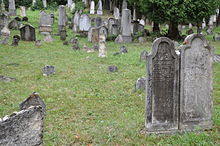Jewish community of Lomnice u Tišnova
The Jewish community Lomnice u Tišnova in the community Lomnice u Tišnova , a minority town in the Czech Republic , existed since the beginning of the 18th century. It was dissolved in 1929, and after 1939 the Jews were deported to concentration camps in several transports .
history
In the so-called Book of Eight (Latin: acta negra maleficorum or liber proscriptorum ) of the Velká Bíteš municipality , a “certain Jew” from Lomnice is mentioned in 1571 - the first written evidence of the Jewish population in Lomnice u Tišnova. In the 16th and 17th centuries there were only a few Jewish families in Lomnice, and the community only grew from the beginning of the 18th century. In 708 Jews from Lysice were resettled to Lomnice , at which time it is believed that Lomnice also had a religious Jewish community with a prayer hall. Around the year 1800 there were about 80 Jewish families with about 611 people in Lomnice, ie at least half of the population. In 1830 there were 606 people, more than a third. After that, the proportion of the Jewish population fell steadily: in 1848 306 people (20%), in 1900 there were 88 people (5%), in 1930 only 30 people (2%).
An independent political Jewish community was established in Lomnice in 1849, but it was merged with the community of Lomnice several times over the next few years and then separated from it again. The religious community was founded in 1886. In the first half of the 19th century there was a yeshiva , a Jewish college, in the Jewish community . A rabbi worked here until 1919.
The belief in a language of the Jews in Lomnice largely depended on their social status. While the richer Jews mostly preferred German, the poorer mostly spoke Czech. After the founding of Czechoslovakia in 1918, the ghetto was relaxed. In the 1920s, the ghetto was no longer only inhabited by Jews, Christian children helped out at Jewish religious ceremonies, and there was no strict distinction between Jews and Christians. Some Jews professed their Czech nationality directly.
The political Jewish community was dissolved on March 18, 1919, the last traces disappeared around 1929 when the streets were reorganized and the houses were renumbered. The religious community was assigned to the community in Brno in 1925, according to other information it was only dissolved in 1928 and 1929 respectively.
The Jewish Quarter
The Jewish quarter, architecturally significant and laid out as a ghetto around the middle of the first half of the 18th century, was located north of the main square and the palace. It consisted of the square Židovské náměstí ( Jewish Square ) and the ulice Josefa Uhra (Josef Uher Street). On the western side was the synagogue, built 1780–1785, on the eastern side the house of the rabbi and the school building. The Jewish quarter also included the Jewish cemetery, located about 200 m north of the synagogue, from the beginning of the 18th century, with the oldest still legible tombstone from 1716. Even older tombstones, dated from 1686 and documented earlier, could be from another Cemetery, probably from Lysice.
holocaust
After the establishment of the Protectorate of Bohemia and Moravia in 1939/1940 around 35 new Jewish citizens came from other, larger communities in the region, who sought alleged protection from persecution in the small community. In autumn 1941, however, their property was confiscated and their freedom of movement was restricted. Deportations were carried out between December 1941 and April 1942. The first transport apparently took place on December 5, 1941 (Transport K), the last and largest from Brno on April 4, 1942 (Transport Ah). The oldest person in this transport was Mrs. Schiller, 86 years old, the youngest then Libuška Tuliss, less than three years old.
After the war, only one person, Jan Líbezný , returned to Lomnice. Otto Liebesný , Markéta Liebesná , Ida Weissbartová and Lilly Luisa Liebesná died in concentration camps. On the occasion of the reopening of the Lomnica Synagogue in 1997, a memorial plaque for the 58 victims of the Holocaust was unveiled. On September 17, 2011, the first five stumbling blocks for the Liebesny family were set in Lomnice.
Individual evidence
- ↑ Historie městyse , portal of the municipality of Lomnice, online at: lomnice.cz / ...
- ↑ a b c d e Lomnice , Portal Holocaust.cz, online at: holocaust.cz / ... ( page no longer available , search in web archives ) Info: The link was automatically marked as defective. Please check the link according to the instructions and then remove this notice.
- ↑ Lomnitz (Moravia) , From the history of the Jewish communities in the German-speaking area, online at: jewische-gemeinden.de / ...
- ↑ a b c d Eva Pavlíčková, Jewish community in Lomnice , bachelor thesis at the Chair of German Language and Literature at Masaryk University in Brno, 2009, online at: is.muni.cz / ... (German)
- ↑ Jana Vojtová, Židé v Lomnici, 2nd edition, Lomnice 2006, ISBN 80-238-5960-9 , p. 17, cited above. according to: Eva Pavlíčková, Jewish community in Lomnice , bachelor thesis at the chair for German language and literature at the Masaryk University in Brno, 2009, online at: is.muni.cz / ... (German)
- ↑ a b c Stolpersteine v Lomnici (Stolpersteine in Lomnice), a documentation about Jews in Lomnice by the Lomnica Beautification Association "Okrašlovací spolek pro Lomnici a okolí" (OSLO), online at: oslomnice.cz / ... ; abridged English version on: oslomnice.cz/


